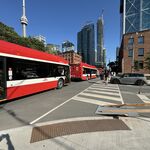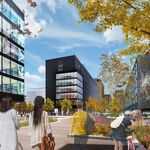July 17 - New, incremental Federal Government transit funding announced - $30 Billion over ten years. My two nominations for the two major still unfunded Toronto transit projects would be the Queens Quay east line and the new subway cars for Line 2 - hopefully some of this funding will find its way there.
The largest public transit investment in Canadian history
NEWS PROVIDED BY
Prime Minister's Office
Jul 17, 2024, 12:01 ET
GREATER TORONTO AREA, ON, July 17, 2024 /CNW/ - Public transit shortens commute times, grows our economy, and helps keep our air clean. For many Canadians – especially Millennials and Gen Z, who frequently use public transit – it's an affordable option to get around. As we build more homes faster, public transit is also key to connecting communities and making life cost less. That's why the federal government is investing in public transit infrastructure – with more jobs, lower emissions, and a fair chance for every generation to get ahead.
Since 2015, we have committed $30 billion into thousands of public transit projects across the country – from new subway lines in Canada's biggest cities, like the Millennium Broadway Subway Extension project in Vancouver and the Finch West light rail line project in Toronto, to new transit serving rural and remote communities – and we know there is more to be done.
The Prime Minister, Justin Trudeau, today announced the launch of the Canada Public Transit Fund, a new $30 billion investment over the first ten years to expand public transit and make it more accessible across the country. This is the largest public transit investment in Canadian history.
The Canada Public Transit Fund will transform the way we deliver transit funding to communities across the country. This permanent ongoing program will invest an average of $3 billion per year to help cities and communities deliver better public transit systems for Canadians.
Funding will be delivered across three streams:
- Metro-Region Agreements will provide extensive funding to support partnerships between provinces and large urban areas with the largest public transit systems, to build the public transit networks Canadians are counting on. This could include regions such as the Greater Toronto Area and other metropolitan areas like Vancouver, Winnipeg, Calgary, Montréal, and Halifax, among others. Funding amounts will be based on merit, with the highest amounts of funding going to the most ambitious partnerships, including those that can best demonstrate how investments in transit will help build more homes.
- Baseline Funding will deliver predictable funding to communities across the country with existing transit systems, based on their population and ridership. This will help communities of all sizes upgrade, replace, or modernize their transit infrastructure, including system expansion, lifecycle extension, performance upgrades, and investments in the state of good repair of their fleets.
- Targeted Funding will be available to support key priorities like active transportation, rural and remote transit, transit investments in Indigenous communities, and the electrification of public transit and school transportation. This funding will be delivered on a project-by-project basis through periodic calls for applications, so the federal government can respond to the evolving transit needs of communities in the future.
Funding will begin to flow in 2026, but we are opening the intakes for Metro-Region Agreements and Baseline Funding today, so that we can provide transit agencies and municipalities with the funding certainty they need to advance projects now.
The Canada Public Transit Fund will also complement our work to build more homes faster. Through programs like the Housing Accelerator Fund, we're giving cities and towns more money to build more homes – but with a condition: if municipalities want federal funding, they have to change their zoning by-laws to build more housing near transit.
As promised in Budget 2024, we're applying that rule to public transit funding as well.
To access long-term, predictable funding through this program, municipalities will need to take actions that directly unlock housing supply. This includes measures to:
- Eliminate all mandatory minimum parking requirements within 800 metres of a high-frequency transit line.
- Allow high-density housing within 800 metres of a high-frequency transit line.
- Allow high-density housing within 800 metres of post-secondary institutions.
- Complete a housing needs assessment for all communities with a population greater than 30,000.





